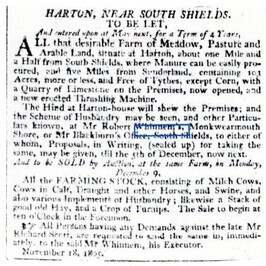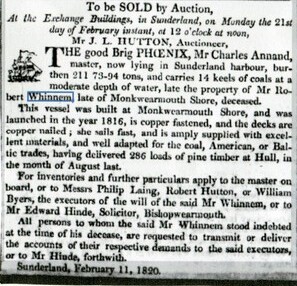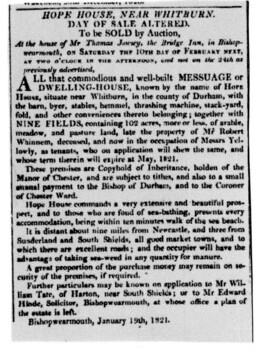
POSTS can now be found under PROJECTS.
| < PART 1 | PART 3 > |
Richard Scott (1740-1804) of South Shields and Harton House Farm
Master Mariner, Ship Owner, Entrepreneur
06 NOVEMBER 2021

PART 2
Robert Whinnem, Shipowner in Monkwearmouth; Executor of Richard Scott's Estate and Guardian of his children!
INTRODUCTION
Moving on from Richard Scott's life I have considered in this part, his legacy, the early lives of his children leading onto shipping connections between the River Tyne and the River Wear Who was Robert Whinnem, in whom Richard Scott had so much faith in nominating him to oversee his estate and provide guardianship for his children (John Scott, his heir, was aged fifteen)?
John Scott (1788-1851)
The son of Hannah Crozier and Richard Scott, he was baptised at St Hilda's Church on the 28 June 1788. Presumably he lived with his parents during his formative years. Later, there is evidence of his shipping interests but to date I have found none relating to an apprenticeship as either shipwright or mariner. He married Ann Horn, the daughter of Elizabeth Pattison (1753-1816) and Thomas Horn (1749-1821) at St. Michael & All Angels Anglican Church, Bishopwearmouth, County Durham on the 8th January 1811.
'John Scott (of this parish) married Ann Horn (of this parish), by Licence
Witnesses: Mary Horn; Robert Horn; Hannah Scott; W. Horn (1)'
I am assuming therefore that Richard Scott's son, John and daughter Hannah re-located to the south side of the River Wear (now Sunderland) before 1810. Their guardian Robert Whinnem was based on the River Wear at Monkwearmouth at the time of Richard Scott's death in 1803. Hannah (Crozier) Scott, Richard's widow died at Bishopwearmouth in 1816 and was interred in the family grave in St Hilda's Churchyard. To date I am uncertain as to what happened to Hannah Scott after 1820. She was a witness at her brother's wedding in 1811 and in 1820 a beneficiary in the will of her guardian Robert Whinnem who listed her address as Bishopwearmouth.
Robert Whinnem 1765-1820
Who was Robert Whinnem in whom Richard Scott had so much faith in nominating him to oversee his estate and provide guardianship for his children? What was the connection between them? In fact I have been unable to locate any records or indeed to find evidence of Robert Whinnem in South Shields in the 18th or first decade of the 19th century. He may have been a shipwright who worked on the Tyne or a Ship's Captain but this is only supposition as there is no evidence to substantiate this. He evidently had a strong association with Philip Laing who was a shipbuilder on the two rivers.
Parish Records
They provide some enlightenment:
1. Robert Whinnem was born in Monkwearmouth, the south side of the River Wear, on the 12th March 1767 the son of Margaret Robinson and Thomas Whinnam and baptised at St Peter's Church (2).
2. Four years earlier the marriage had taken place of his parents:
17 Oct 1763 Thomas Whinnom ship carpenter, age 26, of Monkwearmouth (he was literate) obtained a licence to marry Margaret Robinson (age 19, of Monkwearmouth, daughter of James Robinson, of Monkwearmouth). Surety: Thomas Davison, shipwright, of Sunderland (3).
3. 20 Jul 1795 Robert Whinnom [Wyndham] (of Sunderland) married Jane Dodds (of this parish), by Licence (4).
4. 15 Jan 1818 Robert Whinnem (of this parish) married Ann Wilson (of this parish), by licence. Witnesses: Philip Laing; George Wilson (5).
Post-1800 Records
The spelling of Whinnem varies in the documents I have been able to access and include Whinnam/Whinnom/Whinney/Wyndham. However, he signed his name as Robert Whinnem thesignificant example being that of his will which he signed several times.
1. The first reference I have found relates to his membership of a group attempting to maintain law and order in the districts north of the River Wear; Organisation for the prosecution of felons in Monkwearmouth in 1800 (6). A similar organisation operated in South Shields.
2. The second relates to Harton House Farm in 1805

(7) Despite Richard Scott's wishes that his wife and descendants should remain at Harton House Farm for at least four years, as can be seen in the above notice of sale, this proved not to be the case. The farm was available to let, and the equipment and stock were advertised for selling later in the year that Richard Scott died. The link, however, between Richard Scott and his executor, Robert Whinnem is clearly demonstrated.
3 The next references to Robert Whinnem are on Google:- 'Sunderland Poor Rates Act 1809' he was a contributor to supporting the poor of Monkwearmouth and ‘Historical and Descriptive View of the parishes of Monkwearmouth and Bishopwearmouth and the Port and Borough of Sunderland by George Garbutt,' where he is listed as one of the most influential residents in 1818 (8).
Death Notifications
Three locations are given for the death of Robert Whinnem on the 31st January 1820:
1 WHINNEM On the 31st ult, at Monkwearmouth, Robert WHINNEM, Esq. of Hope House, near Whitburn (9).
2 Feb 1820 Robert Whinnem, of Society Lane, Monkwearmouth, age: 55 (10)
3 Doxford Hall, Bishopwearmouth the home of Philip Laing, one of the executors to his estate. (11)
I suggest that he died at Hope Farm, that his residence in Monkwearmouth was in Society Lane which stretched down to the riverside and that his funeral was from the home of his friend Philip Laing. He was interred in Holy Trinity Churchyard.
Will
He made this on the 25th Jan 1820, in preparation for his seemingly imminent death as he died only six days later. Probate was granted on the 8th February with his estate valued at �4,000. The will is written over eleven pages and has proved to be a source of information about the mysterious Mr Whinnem. I say this, because I have been unable to establish the origins of his wealth and I can find no evidence that he had inherited through his bloodline. His social standing had been elevated to ‘Esq.' by the time of his death and his association with Philip Laing firmly places him in Sunderland middle-class society. He did maintain the link with Richard Scott's son and daughter (the reason that initially I looked into his life)! (12)
Relevant Extracts of his Will
…'To my good friend John Scott of Bishopwearmouth, in the said county of Durham, Gentleman, �1,000 of lawful British money.
…to Hannah Scott of Bishopwearmouth aforesaid, Spinster, the sum of �100 like money'. He also bequeathed to them legacies from various investments including properties and vessels.
Philip Laing of Doxford Hall, Robert Hutton and William Byers were executors of the estate, with financial benefits. They were all linked to shipping. Charles Annand was a witness to the signing who was the Master of his Brig Phoenix which was sold soon after his death.
He died without any direct descendants with both marriages, childless. The will provides an insight into his origins, Thomas Whinnem his father married twice and he named his father's half-siblings as beneficiaries, ‘Robert Whinnem of Felling, William Whinnem/Whinney of South Shields a shipwright (the only reference to South Shields) and the wife of Michael Pearson of Felling (Mary Whinney) at or near the toll bar he has a dwelling house' All three of them received �100.
There were several other legacies ‘Isabella wife of George Bootflower, Thomas Swann, Ann wife of George James' to name a few.
Assets There appears to have been no delay in disposing of some his assets, firstly that of the relatively new Brig Phoenix which was not only a collier but also involved in Trans-Atlantic trade. It was built at Monkwearmouth Shore in close proximity to the home of Robert Whinnem

(13) The names of the executors are re-affirmed: Messrs. Philip Laing, Robert Hutton and William Byers.
Hope House Farm, Whitburn, County Durham

(14) Hope House Farm was located in close proximity to Harton House Farm both of which are now part of South Tyneside. Presumably Richard Scott and Robert Whinnem would have shared experiences of their agrarian lives sharply contrasting with those maritime.
The original proposal according to an earlier advertisement was to let the property and sell the stock, but a year after Robert Whinnem's death the decision was made to sell Hope House Farm in it's entirety which would have been advantageous to the beneficiaries.
Land in County Durham was owned by the Palatinate of Durham and in fact this is still to some extent the case today, with the payments of Ground Rent. In addition the purchaser of the farm would have been subject to the payment of tithes as the farm was in the area then designated as the ‘Manor of Chester'.
The coast line of Whitburn is an area of outstanding beauty of which Hope House Farm would have had an uninterrupted view. ‘Sea-bathing' appears to have been a popular pursuit and in one example from my earlier research, the writer of a letter of 1800 a prosperous family in 1800 were sailing from Shadwell, East London to Cleadon, close to Whitburn and anticipating that her son would benefit from regular sea-bathing.
Comments
I have established that Richard Scott's widow and her surviving son and daughter relocated to Bishopwearmouth on the south side of the River Wear probably soon after his death. Robert Whinnem, Richard's executor, a wealthy and prominent shipowner lived in Monkwearmouth on the north side of the river and Whitburn. The two men had shipping as a shared interest although I have no evidence of joint ventures. Perhaps they were indentured as shipwrights on the River Tyne and I have not ruled out that they were also associated with James Evans (my direct ancestor) shipbuilder and ship owner.
Farm ownership was a surprise area of commonality; Harton House farm in Harton and Hope Farm in Whitburn were approximately three miles apart so prior to Richard Scott's death in 1805, they lived in close proximity.
Harton was my home for ten years or so prior to my marriage in 1975 and where my grandparents bought property in the 1940's. My paternal ancestors, the Smart and Pattison families lived in Harton Village between the 16th and early 19th centuries and also had strong connections to Whitburn and Cleadon (content of a pending post).
It was Harton House Road, built after World War 1 on land that belonged to Harton House Farm that Ridley Scott, the film director born in South Shields in 1937, spent his early years.
The gist of Part 3, the concluding part is the descendants of John Scott, shipping builders on the rivers Tyne and Wear and their family connections with special reference to ‘Notes on The History of Shipbuilding in South Shields 1746-1946 by Amy C Flagg' -1979
References
1. Marriages, Sunderland District - Record Number: 317580.1
2. Family Search (2)
3. Marriages, Sunderland District - Record Number: 406700.14
4. Marriages, Sunderland District - Record Number: 275417.1
5. Marriages, Sunderland District - Record Number: 413142.1
6. Newcastle Courant - Saturday 19 July 1800
7. Newcastle Courant - Saturday 30 November 1805
8. Google references
9. Durham County Advertiser - 9 February 1820
10. Sunderland District Burials-record Number 441670.2
11. Wills-Durham Wills and Inventories (Family Search)
12.Wills-Durham Wills and Inventories (Family Search)
13. Durham County Advertiser - 19 February 1820
14. Durham County Advertiser - Saturday 27 January 1821